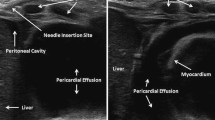Abstract
Background
Central venous cannulation is widely used in neonatal critical care. Pericardial tamponade caused by vessel wall perforation can occur if the catheter tip induces extravasation at the level of the pericardium.
Objective
To investigate the level of the superior pericardial reflection in stillborn babies.
Materials and methods
We dissected 20 bodies (11 female, mean gestational age 33 6/7 weeks, range 25–43 weeks), with careful opening of the thoracic area. After injecting contrast medium into the pericardial sac, we introduced a catheter through the right internal jugular vein. We then took radiographs to analyse the relationship between visual osseous landmarks and the pericardium.
Results
Mean distance between the pericardial reflection at its upper end and the first thoracic vertebra was 1.3 cm (standard deviation [SD]: 0.3 cm) and did not extend over the 3rd intercostal space. The mean distance from the entry of the superior vena cava into the pericardial sac and the 1st thoracic vertebra was 2.3 cm (SD: 0.5).
Conclusion
The upper end of the pericardial reflection in neonates at autopsy lies below the middle of the 3rd thoracic vertebra. The tip of an upper inserted catheter should not extend below the level of the 3rd intercostal space.



Similar content being viewed by others

References
Askegard-Giesmann JR, Caniano DA, Kenney BD (2009) Rare but serious complications of central line insertion. Semin Pediatr Surg 18:73–83
Fusco FP, De Carolis MP, Costa S et al (2008) Cardiac complications in preterm infants with percutaneous long lines: the importance of early diagnosis. Resuscitation 79:506–508
Gravenstein N, Blackshear RH (1991) In vitro evaluation of relative perforating potential of central venous catheters: comparison of materials, selected models, number of lumens, and angles of incidence to simulated membrane. J Clin Monit 7:1–6
Warren M, Thompson KS, Popek EJ et al (2013) Pericardial effusion and cardiac tamponade in neonates: sudden unexpected death associated with total parenteral nutrition via central venous catheterization. Ann Clin Lab Sci 43:163–171
Uchida Y, Sakamoto M, Takahashi H et al (2011) Optimal prediction of the central venous catheter insertion depth on a routine chest X-ray. Nutrition 27:557–560
Kim KO, Jo JO, Kim HS et al (2003) Positioning internal jugular venous catheters using the right third intercostal space in children. Acta Anaesthesiol Scand 47:1284–1286
Bayer O, Schummer C, Richter K et al (2006) Implication of the anatomy of the pericardial reflection on positioning of central venous catheters. J Cardiothorac Vasc Anesth 20:777–780
Sherer DM, Sokolovski M, Dalloul M et al (2006) Fetal clavicle length throughout gestation: a nomogram. Ultrasound Obstet Gynecol 27:306–310
Eifinger F, Brisken K, Roth B et al (2011) Topographical anatomy of central venous system in extremely low-birth weight neonates less than 1,000 grams and the effect of central venous catheter placement. Clin Anat 24:711–716
Na HS, Kim JT, Kim HS et al (2009) Practical anatomic landmarks for determining the insertion depth of central venous catheter in paediatric patients. Br J Anaesth 102:820–823
Eifinger F, Lenze M, Brisken K et al (2009) The anterior to midaxillary line between the 4th or 5th intercostal space (Buelau position) is safe for the use of thoracostomy tubes in preterm and term infants. Paediatr Anaesth 19:612–617
Chaffanjon P, Brichon PY, Faure C et al (1997) Pericardial reflection around the venous aspect of the heart. Surg Radiol Anat 19:17–21
Lofthus RM, Srebnik HH (1987) The physical dimensions of the human neonatal cardiovascular system. J Biomech Eng 109:336–339
Author information
Authors and Affiliations
Corresponding author
Ethics declarations
Conflicts of interest
None
Rights and permissions
About this article
Cite this article
Eifinger, F., Vierzig, A., Roth, B. et al. The pericardial reflection and the tip of the central venous catheter — topographical analysis in stillborn babies. Pediatr Radiol 46, 1528–1531 (2016). https://doi.org/10.1007/s00247-016-3659-y
Received:
Accepted:
Published:
Issue Date:
DOI: https://doi.org/10.1007/s00247-016-3659-y



